Cordova wheel selector plugin
Native wheel selector for Cordova (Android/iOS).
Can use in Cordova or Ionic (v1 or v2) frameworks, calls native API's so no clunky javascript used. Can send in as many data sets as needed, the UI will grow or shrink accordingly (see examples for info).
- Cordova wheel selector plugin
- Installation
- Usage
- Screenshots and Examples
- Ionic
- Development
- TODO
- Credits
Installation
This plugin will work in Ionic v1 AND Ionic v2!
Installation via command line Ionic v1:
cordova plugin add cordova-wheel-selector-plugin
Installation (and Docs) via command line Ionic v2:
https://ionicframework.com/docs/native/wheelselector-plugin/
Usage
The options that can be set
var config = title: "The title" items: //how many items to display, see examples below //the order of the items dictates the order they are displayed in the UI //also the result has an index which refers to the ordering (see examples below) defaultItems: //which items to display, example [{"0" :"2"},{"1" :"Apple"}] (index:value} positiveButtonText: "Yes" negativeButtonText: "No" theme: "light | dark" //lighter or darker theme, not available on iOS yet wrapWheelText: true | false //wrap the wheel for infinite scroll, not available on iOS //advanced usage: displayKey: "description" //so can send in different json - see examples below ; you can also set UIUserInterfaceStyle to Light in your Info.plist file to force the UI to light.
Copy + Paste this into your Info.plist
<key>UIUserInterfaceStyle</key>
<string>Light</string>
The functions that can be called
SelectorCordovaPlugin; //shows the selector SelectorCordovaPlugin; //programatically hides the selector - currently iOS only Screenshots and Examples
Android
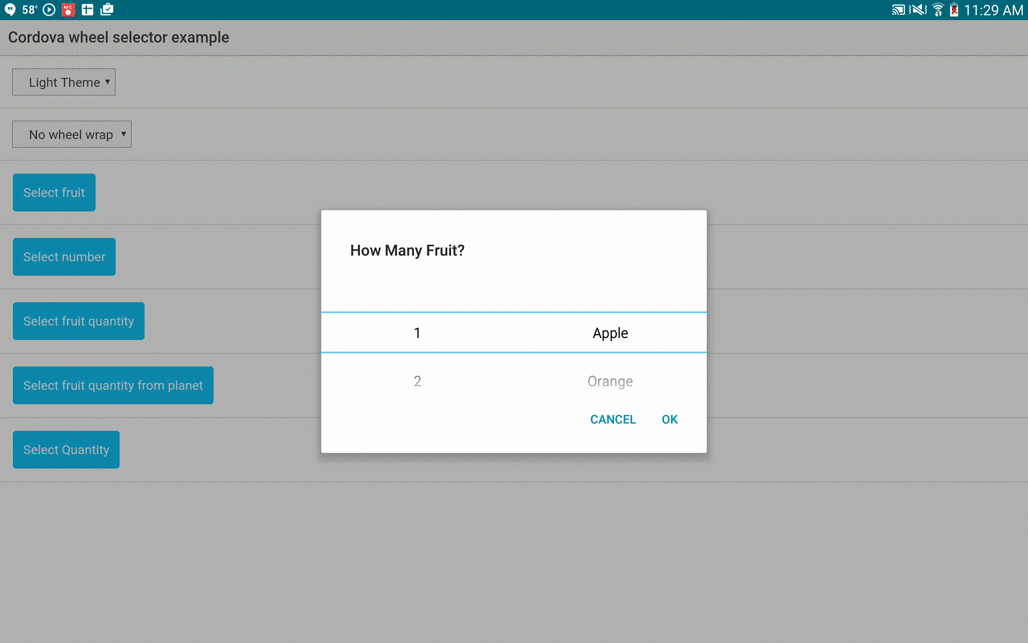
iOS
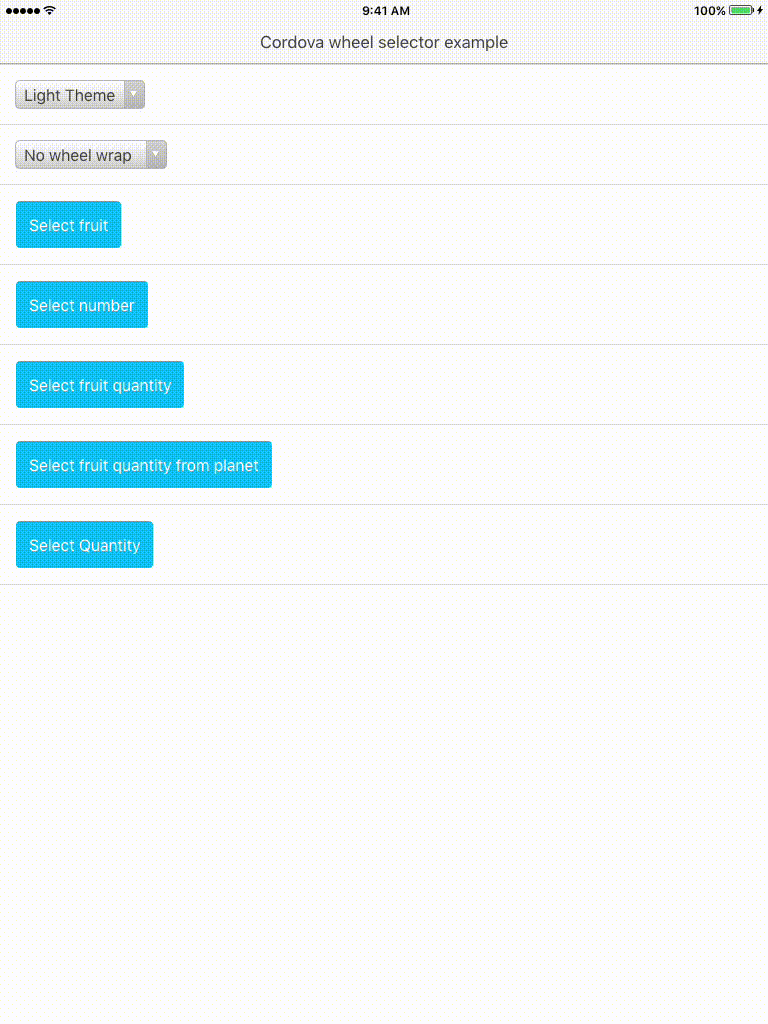
Sample Data
Create your data (or get it from a server API call):
var data = numbers: description: "1" description: "2" description: "3" description: "4" description: "5" description: "6" description: "7" description: "8" description: "9" description: "10" fruits: description: "Apple" description: "Orange" description: "Pear" description: "Banana" description: "Grapefruit" description: "Tangerine" measurements: description: "Teaspoon" description: "Tablespoon" description: "Cup(s)" description: "Quart(s)" description: "Packages (7 oz)" description: "Packages (12 oz)" planets: description: "Venus" description: "Jupiter" description: "Earth" description: "Pluto" description: "Neptune" ; //config here... (see config for each screenshot below to get desired results)var config = ...; //do something useful with the result:windowSelectorCordovaPlugin; Single items, white theme
Using config:
var config = title: "Select a quantity" items: datanumbers positiveButtonText: "Done" negativeButtonText: "Cancel"; Produces:
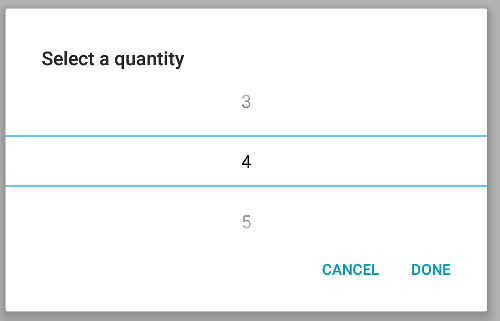
2 items white theme
Using config:
var config = title: "How Many Fruit?" items: datanumbers datafruits positiveButtonText: "Yes" negativeButtonText: "No"; Produces:

Results:
windowSelectorCordovaPlugin; Ouputs:
"result: [{"index":2,"description":"3"},{"index":1,"description":"Orange"}]"
"User chose number: 3 at array index: 2"
"User chose fruit: Orange at array index: 1"
2 items dark theme
Using config:
var config = title: "Select a quantity" items: datanumbers datameasurements theme: "dark" positiveButtonText: "Done" negativeButtonText: "Cancel"; Produces:
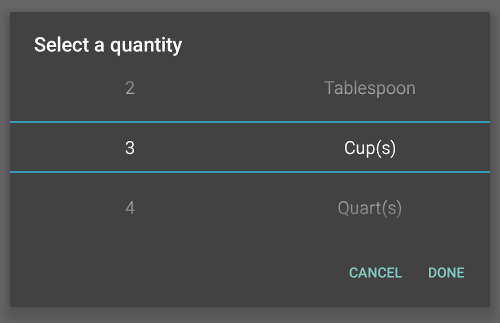
Many items white theme, with 'wheel wrapping'
Using config:
var config = title: "Select something" items: datanumbers datafruits datameasurements dataplanets wrapWheelText: true positiveButtonText: "Cool" negativeButtonText: "No way!"; Produces:
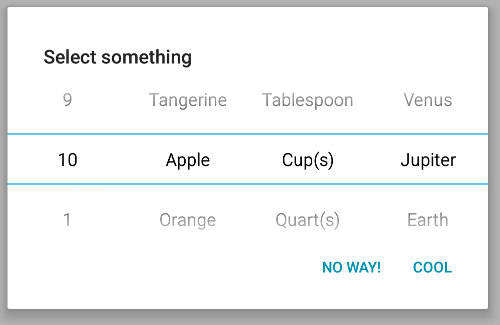
Default items
Note: If you have n items, then you must set n defaultItems, meaning the number of items and number of defaultItems must be the same
Using config:
var config = title: "Select something" items: datanumbers datafruits defaultItems: //the number '2' index:0 value: datanumbers2 //the value 'Pear' index:1 value: datafruits2 ; Will auto select the number "2" and fruit "Pear" (just reference the items in the json array). It could also be hard-coded to the values '2' and 'Pear' but referencing the array is safer (in case a description item isn't in the array), and also avoids duplication of code.
The index defines which list the default item applies to. In the example the list at index 0 in the items array is data.numbers, and the list at index 1 data.fruits.
More complicated usage
In some cases (i.e. retrieving data from a server API call), you may get back differing JSON, in that case you can specify which key to display in the selector using the displayKey in the config, for example if we wish to display the text fields in the corresponding JSON from the following data set:
var data = numbers: //intentional blanks - show up in ui as blanks id: "" text: "" value: "" id: "id1" text: "1" value: "one" id: "id2" text: "2" value:"two" id: "id3" text: "3" value:"three" id: "id4" text: "4" value:"four" id: "id5" text: "5" value:"five" id: "id6" text: "6" value:"six" id: "id7" text: "7" value:"seven" id: "id8" text: "8" value:"eight" id: "id9" text: "9" value:"nine" id: "id10" text: "10" value:"ten" measurements: //intentional blanks - show up in ui as blanks id: "" text: "" value: "" id: "id-17" text: "Teaspoon" value:"1tsp" id: "id-23" text: "Tablespoon" value:"1tbsp" id: "id-88" text: "Cup(s)" value:"1cup" id: "id-54" text: "Quart(s)" value:"1quart" id: "id-32" text: "Package (7 oz)" value:"7ozPckg" id: "id-58" text: "Package (12 oz)" value:"12ozPckg" ; We would use the config, specifying the displayKey field to use text (if no displayKey is defined, the default is description):
var config = title: "Select quantity" items: datanumbers datameasurements wrapWheelText: true positiveButtonText: "Done" negativeButtonText: "Cancel" displayKey: "text"; Which produces:
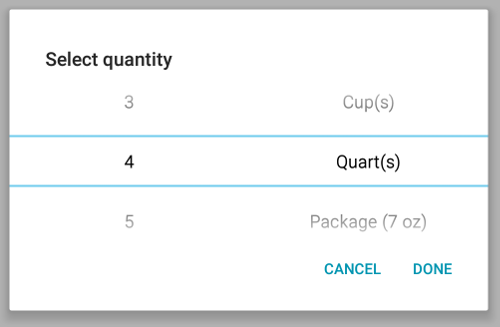
And the corresponding results, you can use the index to retrieve any other values in the original JSON:
windowSelectorCordovaPlugin; Which outputs:
"result: [{"index":4,"text":"4"},{"index":4,"text":""}]""User chose number: 4 at array index: 4 which has value: four and id: id4""User chose measurement: Quart(s) at array index: 4 which has value: 1quart and id: id-54"Note, in the result return value, there is index which is the index in the original JSON to the item the user selected (this allows for reverse-lookups).
Ionic
To use this plugin together with Ionic you can use the offical @ionic-native/wheel-selector plugin wrapper
Development
Kinda a pain to develop these plugins (i.e. haven't figured a good way to unit test).
Clone this project, say you cloned into /home/myuser/git/cordova-wheel-selector-plugin
Install Ionic framework (could create Cordova project as well), and create a project:
ionic start myapp
cd myapp
Android
Install platforms:
ionic platform add android
Install the cordova-wheel-selector-plugin:
cordova plugin add --link /home/myuser/git/cordova-wheel-selector-plugin
(this createss symlinks to the plugin, in the ionic project directory)
Install android studio, and open it, then create a blank project, then:
File->new->import project and browse to the examples/testapp/platforms/android directory and import from that directory (there's a gradle script in there).
This should allow for IDE auto-completion, etc.
If you modify any file other than the .java file you need to uninstall the plugin and re-install it:
cordova plugin rm cordova-wheel-selector-plugin
Then
cordova plugin add --link /home/myuser/git/cordova-wheel-selector-plugin
IOS
Assumes you already have ionic, cordova, npm installed.
cd to cordova-wheel-selector-plugin/examples/testapp dir, type:
./init-ios
which will build it.
Link to local files for the plugin:
./link-local.sh
Can now open the project in Xcode:
cordova-wheel-selector-plugin/examples/testapp/platforms/ios/WheelSelector.xcodeproj
Then build/install/develop as usual in Xcode.
Notes:
To publish to npm
increment version in ./package.json
npm adduser
<Answer prompts for username, password, email if not already setup>
npm publish
TODO
- implement more of the ios portion
- implement normal web browser portion so can run locally in desktop browser
- add more error handling on weird cases
Credits
A lot of this was inspired (and used, especially for the iOS) from this project:
https://github.com/roberthovhannisyan/PhoneGap-Plugin-ListPicker